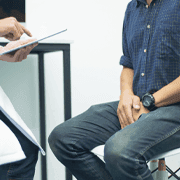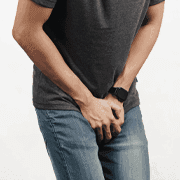How To Heal Circumcision Wounds Faster
In This Article
How To Heal Circumcision Wounds Faster
Elena
Updated on October 17, 2024
Medically verified by Dr. Arya
Fact checked by Dr. Fazeela

Urology
5 min read
Circumcision is a common medical procedure in which the foreskin covering the head of the penis is surgically removed.
Whether performed for religious, cultural, or medical reasons, it’s crucial for proper wound care afterward to ensure a smooth and speedy recovery.
Healing time may vary depending on age, health, and the method used for circumcision, but with the right approach, you can help the body recover faster.
In this blog, Mykare Health will explore practical tips to heal a circumcision wound more quickly, reduce discomfort, and avoid complications. Following these recommendations will help you or your child recover with ease.
What to Expect During Healing
After circumcision, the body initiates its natural healing process. Typically, the wound will form a scab, which helps protect the area and prevent infections.
Healing time for adults can take up to two weeks, whereas infants usually recover within a week to ten days.
It's essential to be patient, as this process cannot be rushed. However, there are ways to encourage faster healing and make the experience more comfortable.
1. Keep the Wound Clean
One of the most important steps in ensuring the circumcision wound heals quickly is maintaining cleanliness. Use mild soap and warm water to gently wash the area.
Avoid scrubbing, as it can irritate the wound. Gently pat the area dry with a soft towel, making sure no moisture is left behind.
For babies, ensure that diapers are changed frequently to prevent exposure to urine or feces, which can infect the wound. Keeping the area dry and clean is vital to speeding up recovery.
2. Avoid Tight Clothing
Wear loose-fitting clothing to avoid friction on the circumcision wound. Tight clothes can cause irritation, discomfort, and slow the healing process by rubbing against the skin.
Loose cotton underwear or a soft cloth can protect the wound and allow for better airflow, which helps the skin heal faster.
3. Use Antiseptic Ointments
Applying a thin layer of antiseptic ointment can help protect the wound from infections. Be sure to follow your doctor’s recommendations on the type of ointment to use.
Many doctors suggest using petroleum jelly or antibiotic ointments like Neosporin to keep the wound moist and reduce the chances of scabbing and scarring. This also prevents the bandage from sticking to the wound.
4. Stay Hydrated
Hydration is critical for wound healing. When the body is well-hydrated, it can repair tissue more efficiently. Make sure you’re drinking plenty of water throughout the day.
For infants, breastfeeding or bottle-feeding regularly will ensure they remain hydrated, which aids in their overall recovery.
5. Follow the Doctor’s Instructions
Each person’s circumcision recovery might differ slightly based on the method used and individual health conditions. Always follow the specific advice given by your healthcare provider.
This includes information on wound care, medication, and activity restrictions. For example, doctors may recommend avoiding strenuous activity or swimming until the wound is fully healed.
 6 min read
6 min readWhat is Stapler Circumcision - Everything You Need to Know
 8 min read
8 min readIs Circumcision Good or Bad - Here's How to Find Out
 8 min read
8 min readCircumcision - Scientific Guide to All Your Questions
Get a Callback Now
6. Pain Management
Pain is common after circumcision, especially in older children and adults. Over-the-counter pain relievers like ibuprofen or acetaminophen can be effective in managing discomfort.
However, avoid using aspirin for young children, as it can increase the risk of a rare but serious condition known as Reye's syndrome.
For babies, you can consult your pediatrician about pain-relief options, such as infant acetaminophen. Keeping the baby calm and comfortable during the healing process will also reduce pain levels.
7. Prevent Infections
Infection is one of the primary concerns after circumcision. Signs of infection include redness, swelling, pus, and a fever.
To prevent this, apply any prescribed antibiotic ointments, and keep the wound clean and dry. If you notice any signs of infection, contact your healthcare provider immediately.
Another way to reduce the risk of infection is by avoiding activities that can expose the wound to bacteria, such as swimming in public pools, hot tubs, or baths (for adults and older children). Instead, opt for quick showers until the wound is healed.
8. Rest and Recovery
Rest is essential for the body to heal any wound. Avoid excessive movement or exercise that can cause strain on the circumcision site. For adults, this means refraining from sexual activity, heavy lifting, and vigorous exercise for at least two to three weeks or until cleared by a doctor.
Infants and toddlers should be kept as comfortable as possible, and any unnecessary physical stress should be minimized. Allowing the body to rest will expedite the healing process.
9. Eat a Healthy Diet
A healthy diet supports your body’s ability to repair itself. Focus on eating foods rich in vitamins and minerals, such as fruits, vegetables, lean proteins, and whole grains. Nutrients like vitamin C, zinc, and protein play a key role in tissue repair and immune function, which can speed up the recovery process.
In children and infants, ensuring proper nutrition whether through breastfeeding, formula, or solid foods will help boost their body’s natural healing abilities.
10. Monitor the Healing Process
Regularly check the wound to make sure it's healing properly. A normal healing wound will gradually improve, with reduced redness and swelling over time.
It's crucial to monitor for any unusual changes, like excessive bleeding, increasing pain, or signs of infection. If any issues arise, don’t hesitate to consult a doctor.
Healing after circumcision can be a smooth process if proper care is taken. By keeping the wound clean, managing pain, and following your doctor’s advice, you can ensure a quicker recovery.
It’s important to remain patient during this time, as everyone’s healing process is different. With the right steps, you or your child will be back to normal in no time.
Cleanliness is crucial : Gently wash the area with mild soap and warm water.
Avoid tight clothing : Loose-fitting clothes prevent friction and irritation.
Use antiseptic ointments : Apply a thin layer to reduce infection risk and keep the wound moist.
Stay hydrated : Drinking plenty of water aids tissue repair and speeds recovery.
Follow doctor’s orders : Adhering to medical advice ensures a smoother healing process.
Pain management is essential : Use pain relievers as recommended to stay comfortable.
Prevent infections : Watch for signs of infection and act quickly if symptoms arise.
Rest and avoid strenuous activity : Give your body time to heal by resting and avoiding pressure on the wound.
Eat a healthy diet : Focus on nutrient-rich foods to support tissue repair.
Monitor the wound regularly : Keep an eye on the healing progress and consult a doctor if anything looks abnormal.
Source Links
treatmentrangehospitals
ucsfbenioffchildrens
medicalnewstoday



